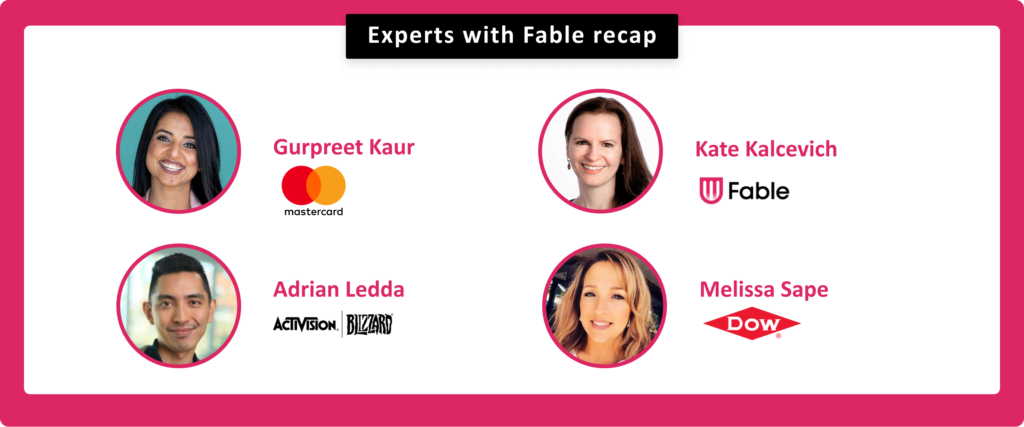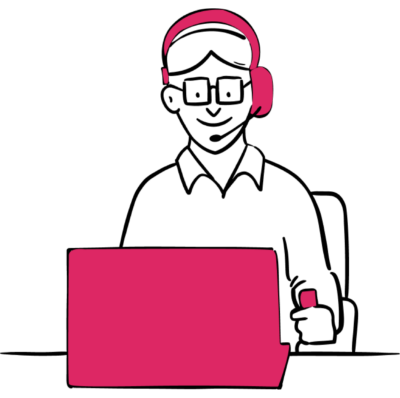
Experts with Fable recap
How successful accessibility leaders measure progress
Experts with Fable is an ongoing webinar series where UX designers, researchers, product managers, engineers and accessibility professionals from leading companies discuss their digital accessibility projects, lessons, and strategies. To stay in the loop about future Experts with Fable, follow us on LinkedIn.
Elodie Fichet, Head of Brand Accessibility at Amazon, moderated a panel discussion with Melissa Sape (Digital Accessibility & Accommodations Service Manager at Dow Chemical Company), Gurpreet Kaur (Vice President of Accessibility & Inclusive Design at Mastercard), Adrian Ledda (Head of Inclusive Game Design at Activision Blizzard), and Kate Kalcevich (Head of Accessibility Innovation at Fable). These accessibility leaders shared their perspectives on best practices for quantifying long-term accessibility outcomes.
Organization structures to support accessibility
“If you don’t measure something, you cannot improve on it.” – Gurpreet Kaur
Grassroots accessibility efforts don’t have a strategic roadmap or the cohesion to move an organization forward. Metrics and measurement are critical when it comes to obtaining buy-in from leadership, something that is key to the success of any accessibility program. Creating a centralized team with executive leadership support allows companies to educate and empower employees to make progress on accessibility.
“We work on building an inclusive culture, inside out… to enable our employees to create experiences that are accessible for everyone.” – Gurpreet Kaur
Useful models for executing accessibility include a hub and spoke where a centralized team and budget is used to procure tools and create resources that benefit the whole organization. Also mentioned in the discussion was the matrix model where individuals across the organization are responsible for accessibility, but are also able to come together and share best practices with each other.
“At Inclusive Game Design we help to remove those barriers or to cross-share learnings to ensure that all teams feel equipped in order to improve and innovate on accessibility.” – Adrian Ledda
Choosing metrics that matter
What you choose to measure regarding accessibility will depend on your company culture, where you are in your journey, and what data is available to you. You want to select data that will help your organization feel motivated, not discouraged, and ultimately standardize how you measure experiences for people with disabilities.
“There’s a lot of data available, but that doesn’t mean that it’s all meaningful data. So, the idea is to choose metrics that clearly indicate where you are in relation to your goals.” – Melissa Sape
Be thoughtful about the metrics that you choose and don’t forget to include qualitative data about the experiences of people with disabilities. Typically, it’s a combination of data and storytelling from real users that helps organizations effectively build empathy and drive teams to take action.
“The goal should not be to achieve perfection, but … align on a goal or North Star and then figure out … what steps you need to take to get from point A to point B.” – Gurpreet Kaur
What to measure beyond WCAG compliance
Fable’s Accessible Usability Scale (AUS) can be used to measure the experiences of assistive technology users with digital products. It’s critical to incorporate people with disabilities into your research for both qualitative and quantitative feedback. For organizations that already rely on the System Usability Scale (SUS), it’s also a metric that will feel well known and easy to adopt.
“We started to take a more human-centred approach to accessibility, and so you’re able to set a baseline based more on user needs and … more focused on things like task completion or… understanding usability for people with disabilities.” – Kate Kalcevich
When digital products are designed with accessibility in mind, you can measure the use of accessibility features and provide a feedback mechanism specifically for accessibility to collect more data. Going beyond compliance, and leveraging usability focused metrics like AUS, also puts the focus on what we are all working towards – building delightful experiences for all of our users.
When to use a maturity model
A maturity model is a framework to help evaluate where an organization is at in its accessibility journey and identify areas for improvement.
“Maturity models have been extremely helpful in understanding where the opportunities [lie or] the gaps in certain teams or products.” – Adrian Ledda
Maturity models can help you benchmark how your accessibility and disability inclusion efforts compare to others in your industry. It can also help you to compare the maturity of different business units inside your organization.
“If you’re in a place where that cross-functional alignment doesn’t exist, the roadmap [for accessibility] hasn’t been agreed to, I think it’s worth investing into that maturity model assessment.” – Gurpreet Kaur
How to get started
Our experts wrapped up the discussion by sharing one tip to start measuring accessibility that doesn’t require a budget:
- Melissa: Implement cost effective first steps to measure accessibility using internal surveys and focus groups.
- Kate: Look at your customer feedback around accessibility.
- Adrian: Develop an internal employee group for knowledge sharing and to create a space for innovation.
- Gurpreet: Start slow, build on the progress, and celebrate small wins.
Learn more about the ROI of accessibility by reading our blog post: The compounding value of investing in digital accessibility and usability.
Watch the full webinar to learn more
Measure accessibility through the experiences of people with disabilities
Are you ready to start benchmarking your digital products and measuring progress on accessibility by engaging with people with disabilities?

